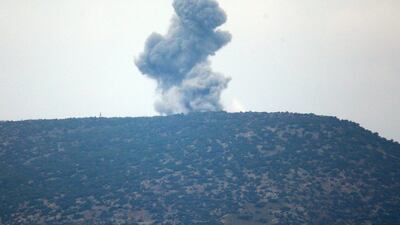The Turkish army's incursion into northern Syria is not the first time it has sent tanks over the border, nor the first time it has clashed with its ally the United States, nor should we be surprised that the Turkish president, Recep Tayyip Erdogan, is determined to crush a Kurdish proto-state to the south.
Nevertheless, Mr Erdogan’s wilful military gambit should be seen as a milestone in the changing power equation of the region, one in which the US is increasingly seen as a bystander.
These are the first shots being fired in the post-ISIL phase of the Syrian war. While ISIL’s so-called caliphate was still in existence, the threat imposed a certain level discipline on the outside powers which have a stake in Syria. With ISIL gone, the next phase is a broader military and diplomatic struggle to decide who will shape the future of Syria.
This is a phase in which the Russians intend to establish new geopolitical realities in the region. How long that timetable may be and whether the Kremlin has the staying power to follow through to the end are open questions. To understand this, it is worth looking at the old set-up.
In 2014, before Russia intervened in the Syrian war to save the regime of Bashar Al Assad, it was a common assumption to predict that the borders of the Levant region agreed between Britain and France in 1916 would have to be redrawn. Indeed, ISIL made a great show of dismantling the frontier between Iraq and Syria.
Four years on, the reality is very different and the borders look firmer than ever: a country called Syria looks set to remain, however weak, and the colonial-era confection of modern Iraq has reinforced its borders by crushing its own Kurdish separatists.
So the prediction was mistaken about the disappearing borders, but not entirely wrong-headed: the Sykes-Picot era is over because there is a new crew of powers in place to oversee the region, replacing those of 1916.
At the end of the First World War, Britain and France, and then America, called the shots. Russia was absent, hamstrung by the Bolshevik Revolution, Turkey was a dream in the mind of Ataturk, and Iran was prey to colonial powers. These countries are now back, with the addition of a bloc of newly assertive Sunni Muslim Arab states.
It can safely be said that the United States prompted the latest crisis. Unwilling to put ground troops into Syria, Washington built up a Kurdish-led militia known as the Syrian Democratic Forces as the spearhead of its advance on ISIL. Last week Rex Tillerson, US secretary of state, announced that US forces, estimated last month at 2,000, would remain in Syria post-ISIL to prevent Iran and the Syrian regime taking over liberated areas in the north, including the country's oilfields.
It was then announced that the US would train and equip a 30,000-strong border force composed of SDF troops, an outfit denounced by Mr Erdogan as an “army of terror” aimed at Turkey.
With these policies the US united the Turks with the Russians and the Iranians. To no one’s surprise, Mr Erdogan set out to clear Syria’s Afrin border district of the Kurdish militia known as the People’s Protection Units or YPG, the armed wing of a local Kurdish party which does not hide its links with the PKK, which has fought the Turkish state for autonomy for decades.
In the past the Turks might have worried about the American reaction, but Washington is a much diminished force and Mr Erdogan has no qualms about going against the wishes of the US military in the interests of what he calls a “national struggle”.
In this case, the chief of staff of the Turkish army, Gen Hulusi Akar, and the intelligence chief Hakan Fidan flew to Moscow to get the green light for the incursion, a necessary condition since the Russians control the airspace. According to the Kurdish leaders in Afrin, the Russians told them they could avoid the coming Turkish hammer blow by handing over control of the district to the Syrian government. Not surprisingly, the Kurds refused. Russia withdrew its military observers from Afrin, and the stage was set for the Turkish advance.
This was a tough choice for the Russians — as guarantor of Syrian sovereignty they cannot be seen to invite an outside power in, which is why they deny any such deal. But the advantage of saying yes were clear: to draw the Turks further away from their Nato allies, the Americans; to show the Kurds that being America’s protege is no protection in 2018; and to demonstrate to the region that there is only one big power engaged in the Syrian conflict, even if Barack Obama once dismissed Vladimir Putin’s Russia as a mere “regional power”.
How long the Turkish incursion will last is not clear. The effect is likely to be a further widening of the gulf of understanding between Turkey and the West. Turkey has no international backing for its incursion, so Mr Erdogan may find himself isolated. But he is unlikely to withdraw until he has made his point that the Kurds’ moment in the sun is passing. As for the Kurds, they are likely to be reminded of their old saying, that they have no friends but the mountains. But they will no doubt be determined to hold on to the territory they control.
As for the Russians, they will be keen to keep Turkey on board for the meeting of the Syrian National Dialogue Congress in Sochi on Monday. While there will be talk of a peace process, the real story is the advance of the regime forces into Idlib province, the last major rebel stronghold, in the north of the country. No doubt the Russians will be looking for Turkish support in this campaign, in exchange for having allowed Mr Erdogan to take his fight to the Kurds.

